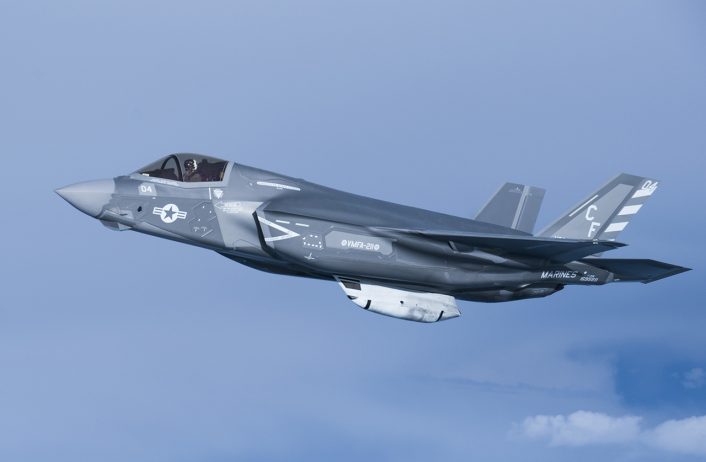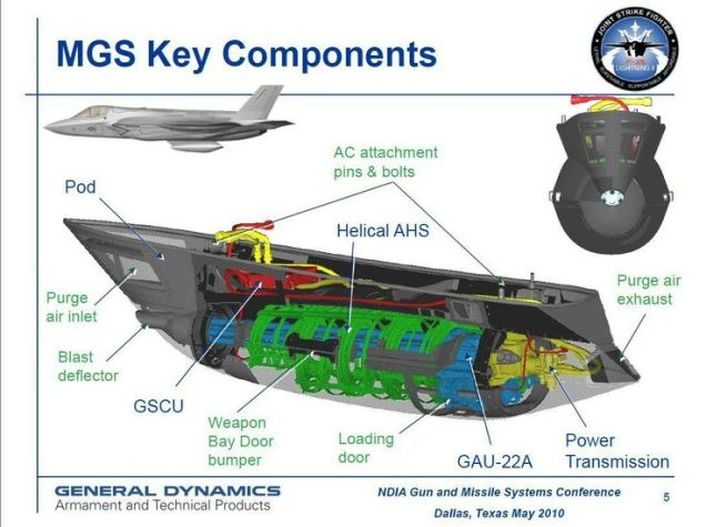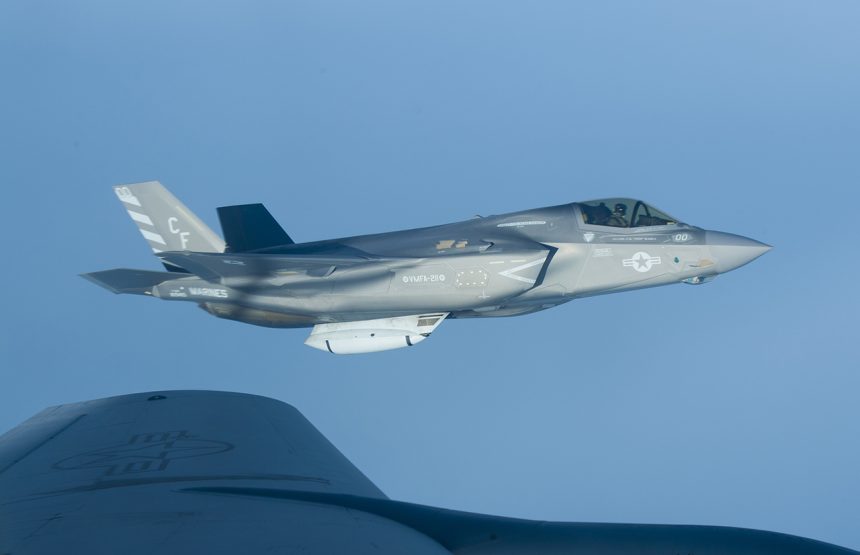Photos show Marines F-35B aircraft carrying the external gun pod during exercise off the coast of Djibouti.
For the last two weeks, U.S. Marine Corps F-35Bs assigned to the Marine Fighter Attack Squadron (VMFA) 211 “Wake Island Avengers”, deployed with the 13th Marine Expeditionary Unit, have undertaken the type’s first operational deployment in international waters off the coast of Djibouti.
Beginning on Sept. 8, the aircraft have taken part in a Theater Amphiobious Combat Rehearsal (TACR) operating from the flight deck of Wasp-class amphibious assault ship USS Essex (LHD 2), deployed to the U.S. Central Command area of responsibility near Horn of Africa along with the rest of the Essex Amphibious Ready Group, that includes the San Antonio-class amphibious transport dock USS Anchorage (LPD 23) and Whidbey Island-class amphibious dock landing ship USS Rushmore (LSD 47).
The F-35B were involved in CAS (Close Air Support) missions, supporting Marines on the ground during drills in the military ranges in Djibouti that, according to USNI News, involved Marine Medium Tiltrotor Squadron 166 (Reinforced)’s complement of CH-53E Super Stallion heavy-lift helicopters, MV-22 Osprey tilt-rotor aircraft, UH-1 Huey utility helicopters and AH-1 Cobra attack helicopters
“The addition of the F-35 to the ARG is a very significant enabler for me and for my team. It increases battlespace awareness with data fusion and the ability to share information with the ships and the ships’ combat control system. So it’s really an extension of our sensors, and it also brings to the table a greater increased lethality than what we had with previous generation aircraft,” Capt. Gerald Olin, Amphibious Squadron 1 commander and Essex ARG/MEU commodore, told USNI News.
The STOVL (Short Take Off Vertical Landing) variant of the stealthy F-35 Lightning II is a key player to the amphibious force: it brings advanced ISR (Intelligence Surveillance Reconnaissance) capabilities where is needed as part of CSO (Crisis Support Operations) that involve the commitment of a quick reation force to respond to tensions in theather to a major conflict that requires the whole capability of the MAGTFs (Marine Air-Ground Task Forces).
Interestingly, photos of the aircraft performing air-to-air refueling from U.S. Air Force KC-135s have been released by the DoD. The shots clearly show the F-35B carrying the GAU-22 25mm gun pod that was test fired for the first time in flight in 2017.

The new General Dynamics GAU-22 25mm gun pod uses a unique four-barrel configuration that was developed from the highly successful five-barrel, 25mm GAU-12/U gun also built by General Dynamics. Noteworthy, although it was designed with LO (Low Observability) characteristics, the external pod degrades the F-35’s radar cross section making the 5th generation aircraft more visibile to radars. Still, this should be acceptable (as it is for the non-stealthy AV-8B Harrier jets they will replace) for the scenarios where the U.S. Marine Corps F-35Bs will be called to carry out CAS missions (read here about the so-called “third day of war” configuration).

The 2018 deployment follows the relocation of Marine Fighter Attack Squadron 121 (VMFA-121), an F-35B squadron with 3rd Marine Aircraft Wing to MCAS Iwakuni, Japan, from MCAS (Marine Corps Air Station) Yuma, Arizona, on Jan. 9, 2017. Since then, the F-35B have started operating in the region, taking part in local drills as well as some routine “shows of force” near the Korean Peninsula: for instance, on Aug. 30, four U.S. Marine Corps F-35B Lightning II joined two USAF B-1B Lancers from Guam onf a 10-hour mission that brought the “package” over waters near Kyushu, Japan, then across the Korean Peninsula. Interestingly, during that mission, the F-35Bs flew with the radar reflectors used to make LO (Low Observable) aircraft clearly visible on radars and also dropped their 1,000-lb GBU-32 JDAMs (Joint Direct Attack Munitions) on Pilsung firing range. On a subsequent mission on Sept. 18, the aircraft took part in a “sequenced bilateral show of force” over the Korean peninsula carrying “live” AIM-120 AMRAAM missiles in the internal weapons bays.









